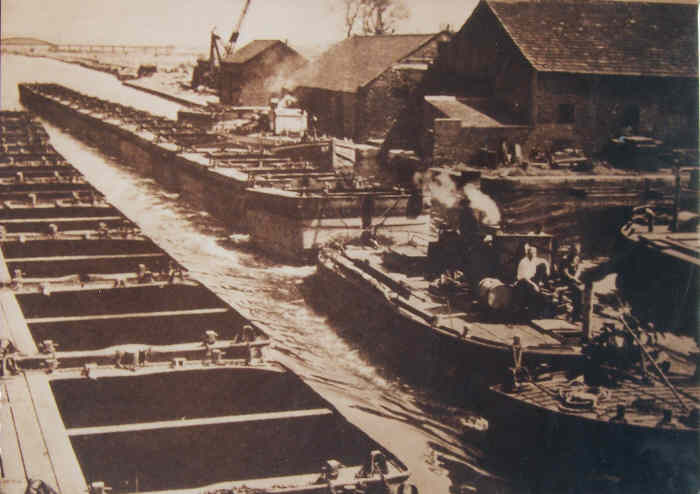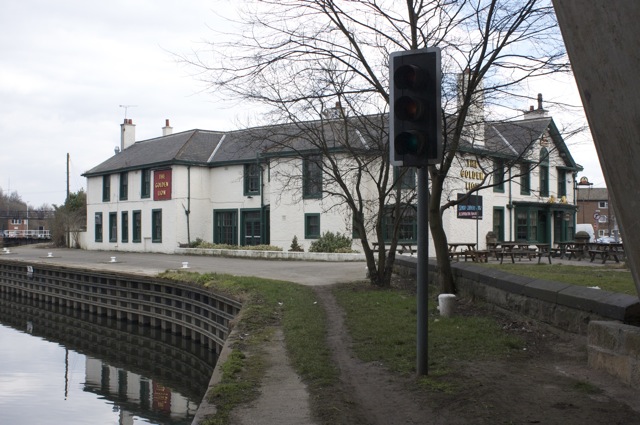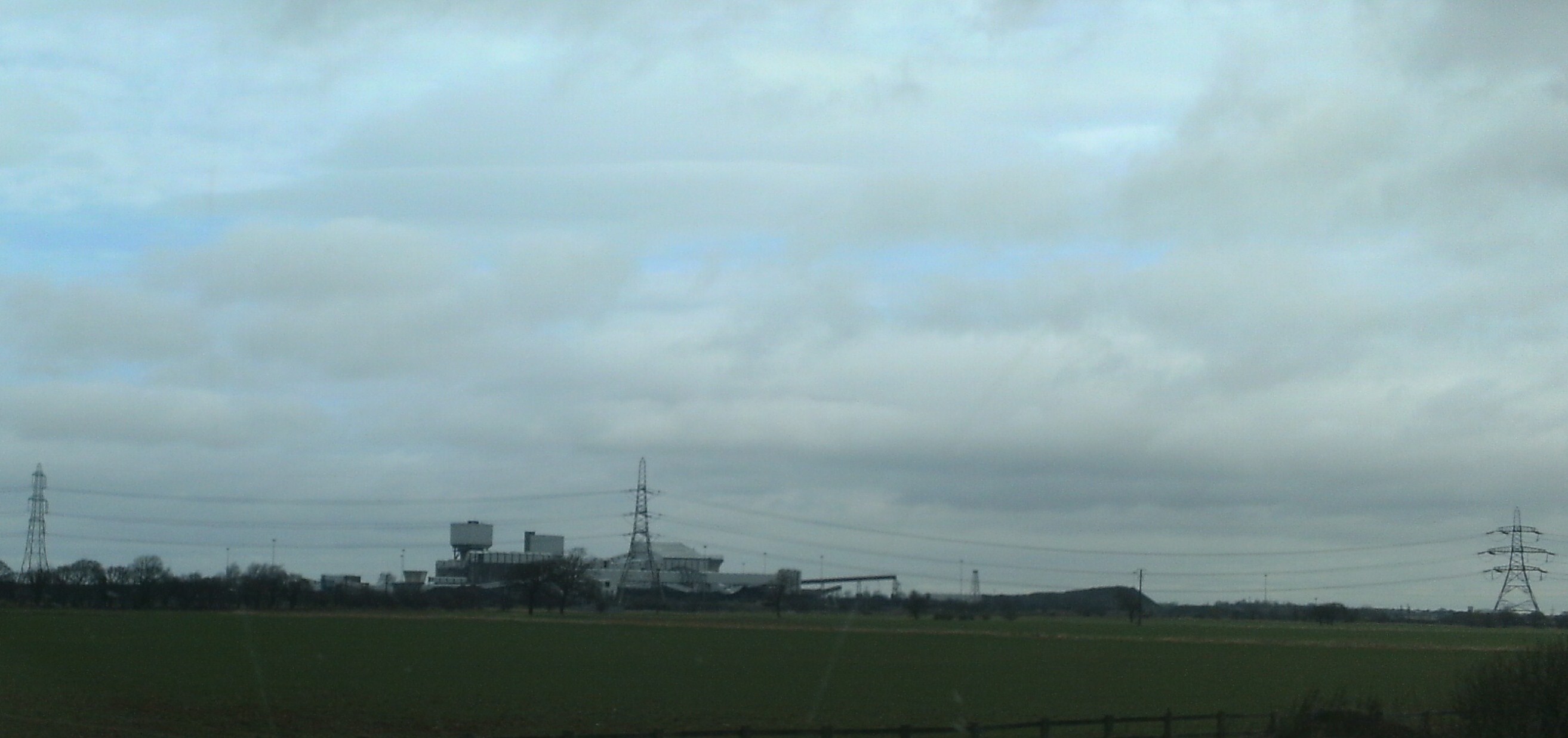|
Tom Pudding
Tom Pudding was the name given to the tub boats on the Aire and Calder Navigation, introduced in 1863 and used until 1985, which were a very efficient means of transferring and transporting coal from the open cast collieries of the South Yorkshire Coalfield near Stanley Ferry to the port of Goole, competing with rail. The name derives from their resemblance to a string of black puddings or perhaps Yorkshire puddings and the first name of the original constructor. Background The use of trains of boats to move bulk products has a long history. In the 1760s, the Third Duke of Bridgwater developed the Navigable Levels at Worsley, which were a series of underground navigable tunnels serving coal workings. They were linked to the Bridgwater Canal, and two sizes of boats were used both underground and on the canal. 'M' boats were and carried 10 tons of coal, while 'T' boats were and carried 7 tons. They were pointed at both ends, as they could not be turned below ground, and were mad ... [...More Info...] [...Related Items...] OR: [Wikipedia] [Google] [Baidu] |
Tom Pudding Boats At Stanley Ferry
Tom or TOM may refer to: * Tom (given name), a diminutive of Thomas or Tomás or an independent Aramaic given name (and a list of people with the name) Characters * Tom Anderson, a character in '' Beavis and Butt-Head'' * Tom Beck, a character in the 1998 American science-fiction disaster movie '' Deep Impact'' * Tom Buchanan, the main antagonist from the 1925 novel ''The Great Gatsby'' * Tom Cat, a character from the ''Tom and Jerry'' cartoons * Tom Lucitor, a character from the American animated series ''Star vs. the Forces of Evil'' * Tom Natsworthy, from the science fantasy novel '' Mortal Engines'' * Tom Nook, a character in ''Animal Crossing'' video game series * Tom Servo, a robot character from the ''Mystery Science Theater 3000'' television series * Tom Sloane, a non-adult character from the animated sitcom ''Daria'' * Talking Tom, the protagonist from the ''Talking Tom & Friends'' franchise * Tom, a character from the '' Deltora Quest'' books by Emily Rodda * Tom, a c ... [...More Info...] [...Related Items...] OR: [Wikipedia] [Google] [Baidu] |
Knottingley
Knottingley is a market town in the City of Wakefield in West Yorkshire, England on the River Aire and the old A1 road (Great Britain), A1 road before it was bypassed as the A1(M). Historic counties of England, Historically part of the West Riding of Yorkshire, it has a population of 13,503, increasing to 13,710 for the City of Wakefield ward at the 2011 Census. It makes up the majority of the Knottingley (electoral ward), Knottingley ward represented on Wakefield Council. Until 1699, it was an important inland river port but, in that year, the Aire was made navigability, navigable as far as Leeds, which soon surpassed it. Knottingley continued as a centre for boat building into the 20th century. In the late 19th century, it started glass manufacturing. The town is served by Knottingley railway station. After 1870, the town became known for glass manufacturing. In 1887 Bagley's Glassworks purchased the rights to the first bottle-making machine, invented by a Ferrybridge postmast ... [...More Info...] [...Related Items...] OR: [Wikipedia] [Google] [Baidu] |
Boat Types
A boat is a watercraft of a large range of types and sizes, but generally smaller than a ship, which is distinguished by its larger size, shape, cargo or passenger capacity, or its ability to carry boats. Small boats are typically found on inland waterways such as rivers and lakes, or in protected coastal areas. However, some boats, such as the whaleboat, were intended for use in an offshore environment. In modern naval terms, a boat is a vessel small enough to be carried aboard a ship. Boats vary in proportion and construction methods with their intended purpose, available materials, or local traditions. Canoes have been used since prehistoric times and remain in use throughout the world for transportation, fishing, and sport. Fishing boats vary widely in style partly to match local conditions. Pleasure craft used in recreational boating include ski boats, pontoon boats, and sailboats. House boats may be used for vacationing or long-term residence. Lighters are used to conve ... [...More Info...] [...Related Items...] OR: [Wikipedia] [Google] [Baidu] |
Ferrybridge
Ferrybridge is a village in West Yorkshire, England. Ferrybridge lies at a historically important crossing of the River Aire which borders the North Yorkshire village of Brotherton. It is linked to other communities by the A1, which follows the route of the Great North Road. The village falls within the Knottingley ward of Wakefield City Council. The origin of the place-name is from Old Norse and means ''bridge by the ferry''. It appears as ''Ferie'' in the Domesday Book of 1086 and as ''Ferybrig'' in 1198. Geography and geology Geologically, Ferrybridge and Knottingley are located on rich soil, over a bed of Magnesian Limestone. The area is close to junctions of the M62 and A1(M) motorways; as well as junctions on the rail network, including northward to York, south to Pontefract (and Rotherham), west to both Wakefield and Leeds, east to Goole and south-east to the East Coast Main Line; the River Aire meets the Aire and Calder navigation close to the east of the town. Th ... [...More Info...] [...Related Items...] OR: [Wikipedia] [Google] [Baidu] |
Kellingley Colliery
Kellingley Colliery was a deep coal mine in North Yorkshire, England, east of Ferrybridge power station. It was owned and operated by UK Coal. The colliery closed on 18 December 2015, marking the end of deep-pit coal mining in Britain. The site is earmarked for commercial development. History Exploratory boreholes sunk in the 1950s established that there were up to seven workable seams of coal at Kellingley. The sinking of its two shafts started in 1960. Its sandy and porous geology down to about was waterlogged. Boreholes drilled around each shaft position had sub-zero-temperature brine pumped through them to freeze the ground down to about . The sinking personnel had to work in sub-zero temperatures until the shafts were below this frozen ground. The shafts were eventually sunk to a depth of around . After a concrete lining sealed the shafts, the cooling brine was stopped and the frozen ground allowed to thaw. Grout, a thin cement mixture, was pumped at high pressure ... [...More Info...] [...Related Items...] OR: [Wikipedia] [Google] [Baidu] |
Canal Inclined Plane
An inclined plane is a type of cable railway used on some canals for raising boats between different water levels. Boats may be conveyed afloat, in caissons, or may be carried in cradles or slings. History Inclined planes have evolved over the centuries. Some of the first were used by the Egyptians to bypass waterfalls on the Nile. These consisted of wooden slides covered with silt which reduced friction. Timeline *600BC – The Diolkos, an early Greek inclined plane, was in use. *385AD – Inclined planes were in use on the Grand Canal in China. *1167 – Nieuwedamme ''overtoom'' (a simple type of incline) was built at Ypres. *1568 – Wagon of Zafosina in use near Venice. *1777 – 3 inclined planes or 'dry wherries' began operation on Dukart's Canal, near Coalisland, in the south-east of County Tyrone in Ulster.''Hadfield's British Canals'' eighth edition Joseph Boughey Page 49 *1788 – An inclined plane was built by William Reynolds and used, for the first time in Engl ... [...More Info...] [...Related Items...] OR: [Wikipedia] [Google] [Baidu] |
Headframe
A headframe (also known as a gallows frame, winding tower, hoist frame,Ernst, Dr.-Ing. Richard (1989). ''Wörterbuch der Industriellen Technik'' (5th ed.). Wiesbaden: Oscar Brandstetter, 1989. pit frame, shafthead frame, headgear, headstock or poppethead) is the structural frame above an underground mine shaft so as to enable the hoisting of machinery, personnel, or materials. Design Modern headframes are built out of steel, concrete or a combination of both. Timber headframes are no longer used in industrialized countries, but are still used in developing nations. Conventionally steel headframes are used when a drum hoist is employed, and concrete headframes are built for friction hoists; however a steel headframe can be used with a friction hoist for shafts with a smaller capacity and depth. Steel headframes A steel headframe is less expensive than a concrete headframe; the tallest steel headframe measures 87 m. Steel headframes are more adaptable to modifications (mak ... [...More Info...] [...Related Items...] OR: [Wikipedia] [Google] [Baidu] |
Transshipment
Transshipment, trans-shipment or transhipment is the shipment of goods or containers to an intermediate destination, then to another destination. One possible reason for transshipment is to change the means of transport during the journey (e.g., from ship transport to road transport), known as transloading. Another reason is to combine small shipments into a large shipment (consolidation), or the opposite: dividing a large shipment into smaller shipments (deconsolidation). Transshipment usually takes place in transport hubs. Much international transshipment also takes place in designated customs areas, thus avoiding the need for customs checks or duties, otherwise a major hindrance for efficient transport. An item handled (from the shipper's point of view) as a single movement is not generally considered transshipped, even if it changes from one mode of transport to another at several points. Previously, it was often not distinguished from transloading, since each leg of such ... [...More Info...] [...Related Items...] OR: [Wikipedia] [Google] [Baidu] |
World War I
World War I (28 July 1914 11 November 1918), often abbreviated as WWI, was one of the deadliest global conflicts in history. Belligerents included much of Europe, the Russian Empire, the United States, and the Ottoman Empire, with fighting occurring throughout Europe, the Middle East, Africa, the Pacific, and parts of Asia. An estimated 9 million soldiers were killed in combat, plus another 23 million wounded, while 5 million civilians died as a result of military action, hunger, and disease. Millions more died in genocides within the Ottoman Empire and in the 1918 influenza pandemic, which was exacerbated by the movement of combatants during the war. Prior to 1914, the European great powers were divided between the Triple Entente (comprising France, Russia, and Britain) and the Triple Alliance (containing Germany, Austria-Hungary, and Italy). Tensions in the Balkans came to a head on 28 June 1914, following the assassination of Archduke Franz Ferdin ... [...More Info...] [...Related Items...] OR: [Wikipedia] [Google] [Baidu] |
Hudswell Clarke
Hudswell, Clarke and Company Limited was an engineering and locomotive building company in Jack Lane, Hunslet, Leeds, West Yorkshire, England. History The company was founded as Hudswell and Clarke in 1860. In 1870 the name was changed to Hudswell, Clarke and Rodgers. There was another change in 1881 to Hudswell, Clarke and Company. The firm became a limited company in 1899. In 1862, soon after the company had been formed, they were given the initial design work on William Hamond Bartholomew's compartment boats for the Aire and Calder Navigation. The choice of the company may have been influenced by the fact that Bartholomew, the chief engineer for the Navigation, and William Clayton, one of the founders of Hudswell and Clarke, both lived on Spencer Place in Leeds. They produced at least one of the prototype Tom Pudding compartments, but did not get the main contract for their production once the design work had been done. As steam locomotive builders, like many of the sm ... [...More Info...] [...Related Items...] OR: [Wikipedia] [Google] [Baidu] |

.jpg)




